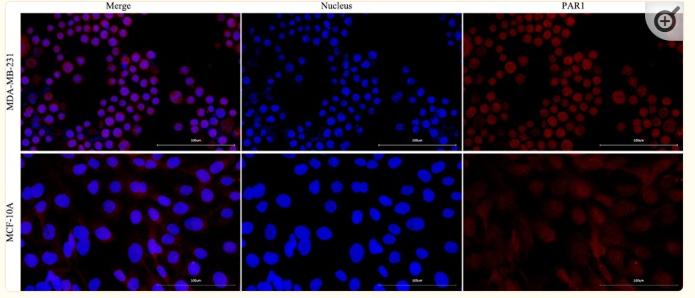Thrombin Receptor Antibody - #AF0263
| Product: | Thrombin Receptor Antibody |
| Catalog: | AF0263 |
| Description: | Rabbit polyclonal antibody to Thrombin Receptor |
| Application: | WB IHC IF/ICC |
| Reactivity: | Human, Mouse, Rat |
| Mol.Wt.: | 48kDa; 47kD(Calculated). |
| Uniprot: | P25116 |
| RRID: | AB_2833437 |
Related Downloads
Protocols
Product Info
*The optimal dilutions should be determined by the end user.
*Tips:
WB: For western blot detection of denatured protein samples. IHC: For immunohistochemical detection of paraffin sections (IHC-p) or frozen sections (IHC-f) of tissue samples. IF/ICC: For immunofluorescence detection of cell samples. ELISA(peptide): For ELISA detection of antigenic peptide.
Cite Format: Affinity Biosciences Cat# AF0263, RRID:AB_2833437.
Fold/Unfold
CF2R; Coagulation factor II (thrombin) receptor; Coagulation factor II receptor; F2R; HTR; PAR 1; PAR-1; PAR1; PAR1_HUMAN; Protease activated receptor 1; Proteinase activated receptor 1; Proteinase-activated receptor 1; Thrombin receptor; TR;
Immunogens
- P25116 PAR1_HUMAN:
- Protein BLAST With
- NCBI/
- ExPASy/
- Uniprot
MGPRRLLLVAACFSLCGPLLSARTRARRPESKATNATLDPRSFLLRNPNDKYEPFWEDEEKNESGLTEYRLVSINKSSPLQKQLPAFISEDASGYLTSSWLTLFVPSVYTGVFVVSLPLNIMAIVVFILKMKVKKPAVVYMLHLATADVLFVSVLPFKISYYFSGSDWQFGSELCRFVTAAFYCNMYASILLMTVISIDRFLAVVYPMQSLSWRTLGRASFTCLAIWALAIAGVVPLLLKEQTIQVPGLNITTCHDVLNETLLEGYYAYYFSAFSAVFFFVPLIISTVCYVSIIRCLSSSAVANRSKKSRALFLSAAVFCIFIICFGPTNVLLIAHYSFLSHTSTTEAAYFAYLLCVCVSSISCCIDPLIYYYASSECQRYVYSILCCKESSDPSSYNSSGQLMASKMDTCSSNLNNSIYKKLLT
PTMs - P25116 As Substrate
| Site | PTM Type | Enzyme | Source |
|---|---|---|---|
| K51 | Ubiquitination | Uniprot | |
| Y52 | Phosphorylation | Uniprot | |
| Y69 | Phosphorylation | Uniprot | |
| S306 | Phosphorylation | Uniprot | |
| S375 | Phosphorylation | Uniprot | |
| S376 | Phosphorylation | Uniprot | |
| Y383 | Phosphorylation | Uniprot | |
| S384 | Phosphorylation | Uniprot | |
| S391 | Phosphorylation | Uniprot | |
| S392 | Phosphorylation | Uniprot | |
| S395 | Phosphorylation | Uniprot | |
| S396 | Phosphorylation | Uniprot | |
| Y397 | Phosphorylation | Uniprot | |
| S399 | Phosphorylation | Uniprot | |
| S400 | Phosphorylation | Uniprot | |
| S406 | Phosphorylation | Uniprot | |
| K407 | Ubiquitination | Uniprot | |
| T410 | Phosphorylation | Uniprot | |
| S412 | Phosphorylation | Uniprot | |
| S413 | Phosphorylation | Uniprot | |
| S418 | Phosphorylation | Uniprot | |
| Y420 | Phosphorylation | Uniprot | |
| K421 | Ubiquitination | Uniprot | |
| K422 | Ubiquitination | Uniprot | |
| T425 | Phosphorylation | Uniprot |
Research Backgrounds
High affinity receptor for activated thrombin coupled to G proteins that stimulate phosphoinositide hydrolysis. May play a role in platelets activation and in vascular development.
A proteolytic cleavage generates a new N-terminus that functions as a tethered ligand.
Phosphorylated in the C-terminal tail; probably mediating desensitization prior to the uncoupling and internalization of the receptor.
Cell membrane>Multi-pass membrane protein.
Platelets and vascular endothelial cells.
The cleaved signal peptide may not be degraded and may function as an intracellular angiogenesis inhibitor peptide known as parstatin.
Belongs to the G-protein coupled receptor 1 family.
Research Fields
· Cellular Processes > Cell motility > Regulation of actin cytoskeleton. (View pathway)
· Environmental Information Processing > Signal transduction > Rap1 signaling pathway. (View pathway)
· Environmental Information Processing > Signal transduction > Calcium signaling pathway. (View pathway)
· Environmental Information Processing > Signal transduction > cAMP signaling pathway. (View pathway)
· Environmental Information Processing > Signal transduction > Phospholipase D signaling pathway. (View pathway)
· Environmental Information Processing > Signaling molecules and interaction > Neuroactive ligand-receptor interaction.
· Environmental Information Processing > Signal transduction > PI3K-Akt signaling pathway. (View pathway)
· Human Diseases > Cancers: Overview > Pathways in cancer. (View pathway)
· Organismal Systems > Immune system > Complement and coagulation cascades. (View pathway)
· Organismal Systems > Immune system > Platelet activation. (View pathway)
References
Application: IF/ICC Species: Human Sample: MDA-MB-231 and MCF-10A cells
Application: IF/ICC Species: human Sample:
Restrictive clause
Affinity Biosciences tests all products strictly. Citations are provided as a resource for additional applications that have not been validated by Affinity Biosciences. Please choose the appropriate format for each application and consult Materials and Methods sections for additional details about the use of any product in these publications.
For Research Use Only.
Not for use in diagnostic or therapeutic procedures. Not for resale. Not for distribution without written consent. Affinity Biosciences will not be held responsible for patent infringement or other violations that may occur with the use of our products. Affinity Biosciences, Affinity Biosciences Logo and all other trademarks are the property of Affinity Biosciences LTD.


